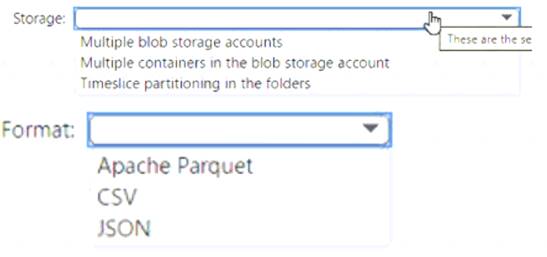- (Exam Topic 3)
Note: This question is part of a series of questions that present the same scenario. Each question in the series contains a unique solution that might meet the stated goals. Some question sets might have more than one correct solution, while others might not have a correct solution.
After you answer a question in this scenario, you will NOT be able to return to it. As a result, these questions will not appear in the review screen.
You have an Azure Storage account that contains 100 GB of files. The files contain text and numerical values. 75% of the rows contain description data that has an average length of 1.1 MB.
You plan to copy the data from the storage account to an Azure SQL data warehouse. You need to prepare the files to ensure that the data copies quickly.
Solution: You modify the files to ensure that each row is less than 1 MB. Does this meet the goal?
Correct Answer:
A
When exporting data into an ORC File Format, you might get Java out-of-memory errors when there are large text columns. To work around this limitation, export only a subset of the columns.
References:
https://docs.microsoft.com/en-us/azure/sql-data-warehouse/guidance-for-loading-data
- (Exam Topic 1)
You need to design an analytical storage solution for the transactional data. The solution must meet the sales transaction dataset requirements.
What should you include in the solution? To answer, select the appropriate options in the answer area.
NOTE: Each correct selection is worth one point.
Solution:
Graphical user interface, text, application, table Description automatically generated
Box 1: Round-robin
Round-robin tables are useful for improving loading speed.
Scenario: Partition data that contains sales transaction records. Partitions must be designed to provide efficient loads by month.
Box 2: Hash
Hash-distributed tables improve query performance on large fact tables. Reference:
https://docs.microsoft.com/en-us/azure/synapse-analytics/sql-data-warehouse/sql-data-warehouse-tables-distribu
Does this meet the goal?
Correct Answer:
A
- (Exam Topic 3)
You have an Azure Data Factory pipeline that contains a data flow. The data flow contains the following expression.
Solution:
See below answer.
Does this meet the goal?
Correct Answer:
A
- (Exam Topic 3)
You have an Azure Blob storage account that contains a folder. The folder contains 120,000 files. Each file contains 62 columns.
Each day, 1,500 new files are added to the folder.
You plan to incrementally load five data columns from each new file into an Azure Synapse Analytics workspace.
You need to minimize how long it takes to perform the incremental loads.
What should you use to store the files and format?
Solution:
Box 1 = timeslice partitioning in the foldersThis means that you should organize your files into folders based on a time attribute, such as year, month, day, or hour. For example, you can have a folder structure like
/yyyy/mm/dd/file.csv. This way, you can easily identify and load only the new files that are added each day by using a time filter in your Azure Synapse pipeline12. Timeslice partitioning can also improve the performance of data loading and querying by reducing the number of files that need to be scanned
Box = 2 Apache Parquet This is because Parquet is a columnar file format that can efficiently store and compress data with many columns. Parquet files can also be partitioned by a time attribute, which can improve the performance of incremental loading and querying by reducing the number of files that need to be scanned1 23. Parquet files are supported by both dedicated SQL pool and serverless SQL pool in Azure Synapse Analytics2.
Does this meet the goal?
Correct Answer:
A
- (Exam Topic 3)
You have an Azure subscription that contains an Azure Data Lake Storage account named myaccount1. The myaccount1 account contains two containers named container1 and contained. The subscription is linked to an Azure Active Directory (Azure AD) tenant that contains a security group named Group1.
You need to grant Group1 read access to contamer1. The solution must use the principle of least privilege. Which role should you assign to Group1?
Correct Answer:
A

